Green Revolution
Posted in: Uncategorized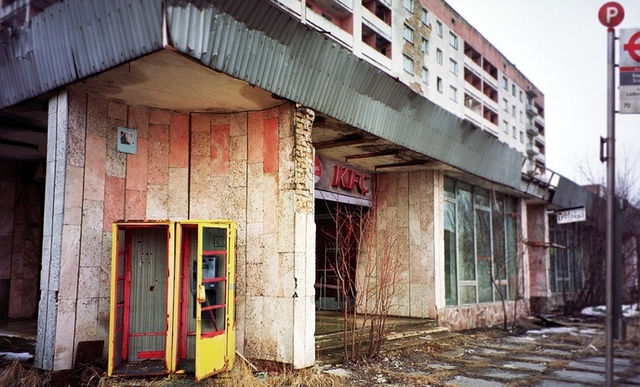

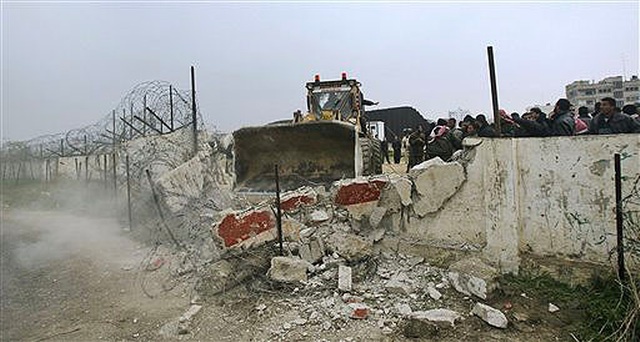
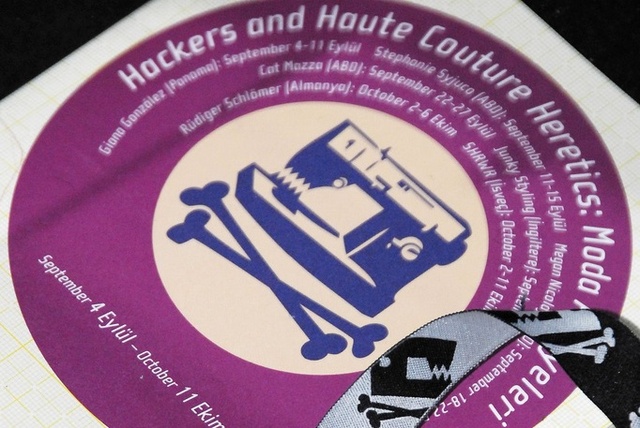
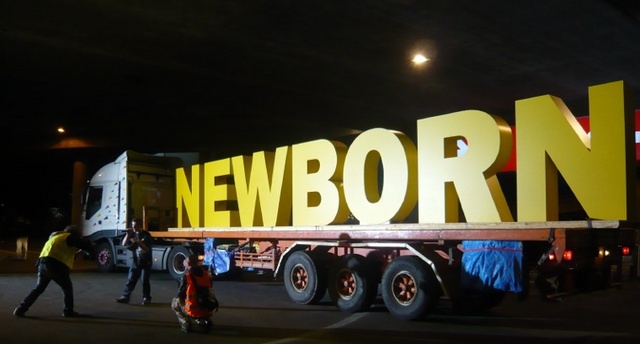
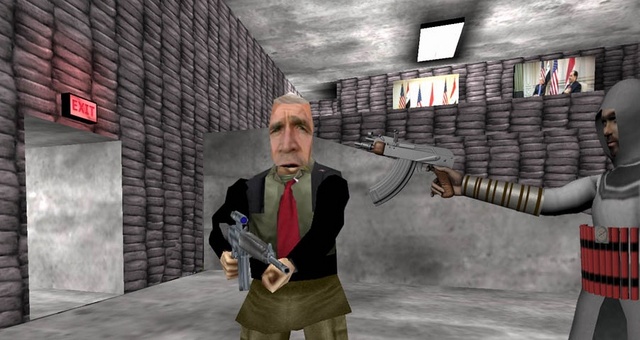

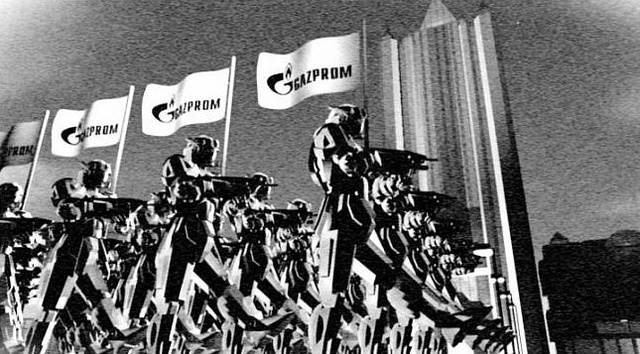
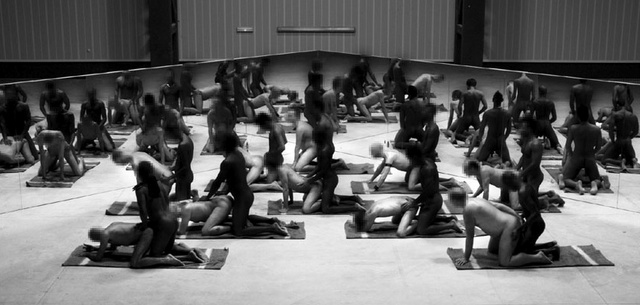
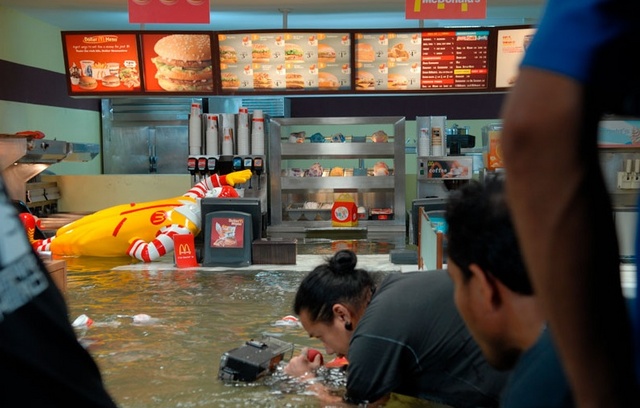
At the end of next week, i’m going to be at the University of Architecture in Alicante for a workshop headed by Jose Perez de Lama and Pablo de Soto from hackitectura. I’m particularly glad to be working with them as i’ve been admiring their work for a few years now (cf. one of their previous works, Situation Room.)
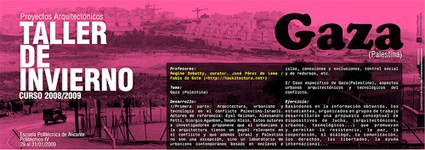
The title of the workshop is Gaza (Palestina). Architecture, urbanism and technologies in the conflict Palestina/Israel. The objective of this (complex and how so delicate) event is to study the conflict and the role architecture and urbanism have in its development, but also to explore how a kind of laboratory of contemporary urbanism has emerged from the situation: gated communities, social controls, isolated islands, connections and disconnections, exclusion, alienations, etc.
Pablo has spent the past few weeks in Egypt where he is creating an alternative cartography of the frontier between Egypt and Gaza, more precisely in Rafah. We are collecting videos, information, links, online essays, artistic experiences, etc. Anything that could help us get a better picture of the issue and trigger ideas in the brain of the smart little students who would have to come up with proposals that foster and allow dialog, resistance, peace, human rights, communication, freedom, mutual understanding, international help, etc. That’s where i’m asking you if you have any suggestion of information we could use. You could either add them to my del.icio.us links by tagging the links with for:regine, add comments on this post or write me to the usual address (see second column on the homepage).
I’m going to document all our findings as well as the development of the workshop on a separate blog. Will update this post with a link to it next week.
Two of my favourite mags The Journal of Aesthetics and Protest and Volume are out:
Volume is an architecture and urbanism magazine. It’s neither a highly specialized print that mere mortals like me find hard to approach nor is it one of those glossy Vogue-lookalikes with chichi spreads of fashionably ‘sustainable’ buildings. It’s not ‘something in between’ either.
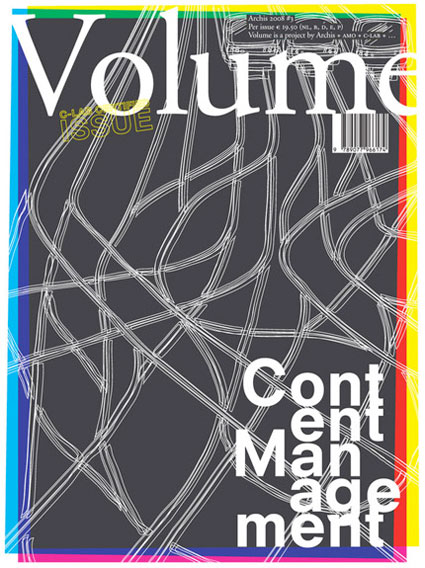
This issue presents many trends, people, ideas that might look like they do not directly belong to the world of architecture and urbanism but are perfectly pertinent and relevant to architects and urbanists. And because almost anything architects and urbanists do ends up concerning the hoi polloi (that’s you and me, my friend), there’s much food for thoughts and heated discussions in Volume 17:
The editors explain: At the close of this era of expansion and surplus Volume speculates on one of the period’s emblematic inventions: Content Management, or the collecting, organizing and sharing of digital information. Our retrospective appraisal of recent developments in the managing of information offers inside into the ability of Content Management to serve the current realities of digital abundance and material shortage, and to protect both vast and extremely limited quantities.
Jesse Seegers and Jeffrey Inaba quizz Ken Goldberg on burning dollar bills and other less trivial matters, Chris Anderson about ‘free’ culture and PageRanking on business cards. They also get Julien De Smedt to discuss his views on free-wheel experiementation, the proliferation of ‘post-OMA offices’, why not choosing and mismanaging can be valuable strategies. Benedict Clouette and Forrest Jessee’s interview with publisher Lars Müller (whose Face of Human Rights is on my must read list) evokes books as a form of content management.
Volume dives into almost mainstream US culture with an interview of Rachel Maddow (available online) and another one with Arianna Huffington (best enjoyed after having savoured this article about the so-called death of the blogosphere.)
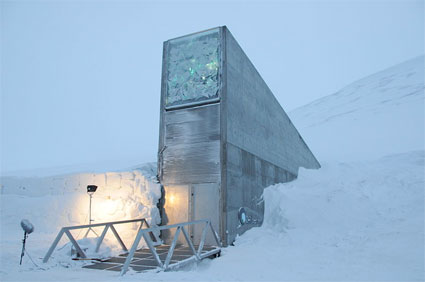
Entrance of the Svalbard Global Seed Vault. Credit: Mari Tefre / Global Crop Diversity Trust (more images)
Those are only a few of the many interviews of smart people by other smart people.
Just to contradict all the above i should add that many of the issues covered in Volume 17
1. are not interviews. C-LAB explores the World Heritage, the content management system for cultural and natural treasures. Easy happiness is at reach in “Architecture is Merciless”, a presentation by Jacques Herzog about Beijing’s Bird Nest and in a short series of photos that display how Vogt Landscape Architects transplant nature into a constructed context. “Seeds of Paranoia” gives the lowdown on the Svalbard Global Seed Vault. This must be one of the rare articles that goes beyond the hype aspect of the project.
2. openly belong to the world of architecture. For example, Professor of Architecture at Columbia University Mark Wigley has a short essay on architecture seen under the lens of content management.
The Journal of Aesthetics and Protest by the same publishers who released the very excellent the book, An Atlas of Radical Cartography.
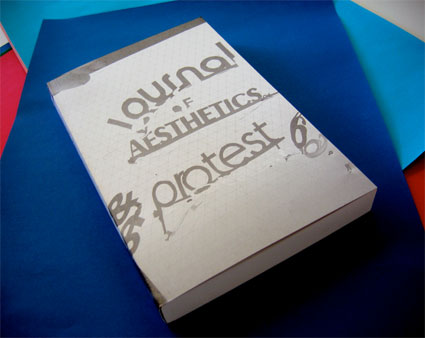
Among all paper magazines, JoA&P is probably the one most likely to truly and gently give rise to social changes. Smart, wonderfully edited and available for a mere $15, the magazine is heavily centered on the US scene and i wonder if we have anything similar in Europe. And if we don’t i wonder what we’re waiting for.
The 300 pages of the sixth issue are broken down in three ‘conceptual’ sections.
1. I Love To We is a call for a new terminology to describe the formations of grassroots cultural resistant practices. These “interventions, strategies and tactics in the territory” explore the war on terror and the global order. A quick selection of the many essays featured in this section: LA-based organization Bicicocina (or Bicycle Kitchen) describes its self-assigned mission to teach people to work on their own bikes. Lisa Anne Auerbach wrote an insightful essay on the new “Don’t Do It Yourself” battle triggered by corporations’ avid assault and capitalisation of the D.I.Y. culture. Aimee Le Duc analyzes what happens when an old police station in San Francisco is bought and transformed into a home and office by someone like artist and architect Bruce Tomb.
2. Antiwar Survey Respondents has almost 20 activists not only describe their antiwar activities but also answer vital questions such as “How do you measure success for this activity?’ and ‘In order to continue and be successful with this or other related activities, what would you do or need?’ The answers should convince readers that activist actions do have an impact and inspire them to join the movements or start their own.
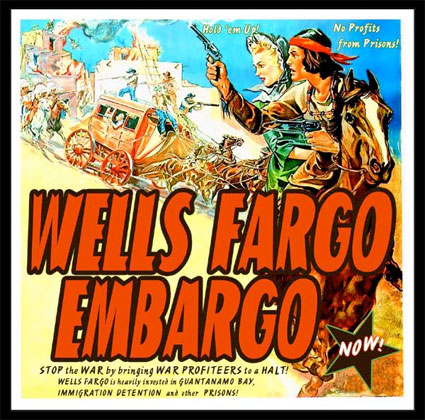
Center for Tactical Magic collaborating with UC Santa Cruz students on Wells Fargo Embargo
3. Another Theory Section. Under a title which could hardly get any more cloudy and bland are a handful of lessons learnt (sometimes the hard way) by artists and activists: problems encountered when trying to get art in public space, the recent history of the art collective in light of the persecution of the Critcal Art Ensemble, the danger of nostalgia to culture, etc.
The Helga de Alvear gallery in Madrid is currently running a (very timely) exhibition on the controversial topic of Extraordinary Rendition. The expression was coined by the Bush administration to define new legal measures designed to sidestep the existing Human Rights system and deprive some individuals from its protection in the name of the fight against terrorism.

Detainees at Camp X-Ray, at Naval Base Guantanamo Bay, Cuba
The Patriot Act, for example, expands the authority of US law enforcement agencies for “terrorism investigation.” It limits -when it does not completely abolish it- citizens’ right to privacy or freedom of expression, allows for kidnapping and confinement of persons without charges, without trial or a detention period as has been happening in Guantanamo since 2002.
The gallery invited four renowned artists to reflect on the issue.
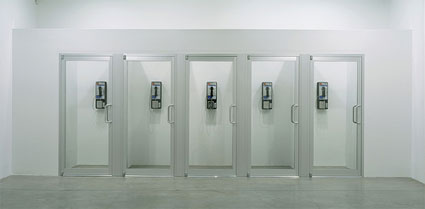
Elmgreen and Dragset, Phone Home, 2008
Phone Home (2003), by Elmgreen & Dragset, is the only work on exhibit that has not been created specifically for the show. The installation looks at the loss of the right to privacy in communications. Five telephone cabins are lined up in the gallery. A note informs visitors that they can call anyone they want in the world for free. Of course there’s a trick: the conversation you are planning to have will be broadcast in the gallery, recorded and a table with audio players and headphones will enable future visitors to listen to what you said.
Under the new rules of extraordinary rendition, physical and psychological torture is justified. Spanish Inquisition-like methods of torture get toned down but that’s because some of them are given new names, like waterboarding, in an attempt to disguise their true meaning.
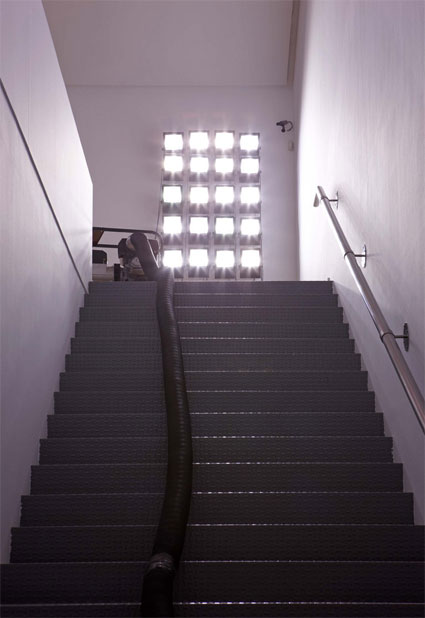
Santiago Sierra, Público iluminado con generador de gasolina, 2008
True to his wam bam approach, Santiago Sierra chose to address torture and one of its most commonly applied methods: the sleep deprivation of detainees for days and months. A huge spotlight operated by a generator are the only elements in Público iluminado con generador de gasolina [Public illuminated by oil generator]. Unfortunately the gallery had run out of oil (another very timely issue) when i went there and the installation was turned off.
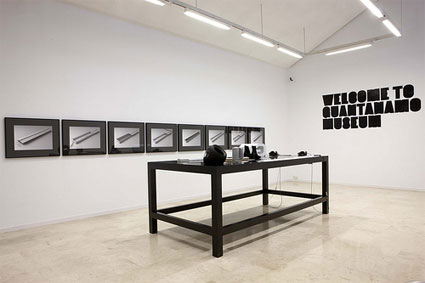
Alicia Framis, Welcome to Guantanamo, 2008. Image courtesy of GalerÃa Helga de Alvear, Madrid
Alicia Framis is presenting the first part of a wider project called Welcome to Guantánamo Museum. The installation documents the key elements that would form this hypothetical museum on the US detention centre in Cuba. Scale models, drawings, prototypes, floor plans and structures are exhibited together with an audio piece created with Enrique Vila Matas and Blixa Bargeld. The project echoes our society’s need to museify everything, think of Auschwitz and Alcatraz. Should we recoil at the idea of turning horror into a tourist attraction or should we decide that such museums are not a necessary evil, a way of ensuring that atrocities are not forgotten?
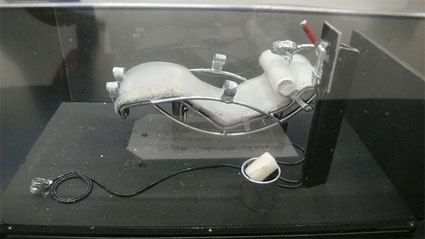
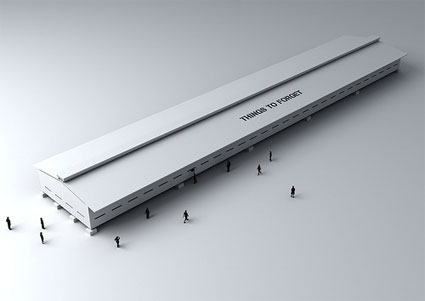
Alicia Framis, Welcome to Guantanamo, 2008. Image courtesy of GalerÃa Helga de Alvear, Madrid
The proposal for a Guantanamo Museum will include a selection of exhibition objects and merchandising that reflect the museum’s theme and motto — Things to forget. There will be a Le Corbusier chaise longue turned into an electric chair, a non-existent mailbox, shoes which contain inside their heels a system to allow prisoners to commit suicide, a series of orange clothing and objects designed by Framis together with students during workshops, furniture for the museum will be designed and built using the material of inmates’ cells, etc. At the same time a sound room will recall the names of all the caged prisoners in Guantanamo.
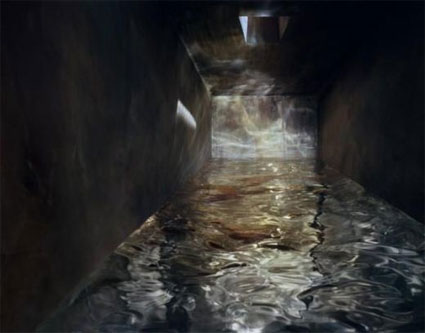
James Casebere, Flooded cell #2, 2008
James Casebere made photos of what he calls Flooded Cells. These images conjure up allusions to prisons, claustrophobic and oppressive spaces somehow reminiscent of Piranesi‘s fictitious and distressing prisons (carceri) yet also referencing the method of torture by simulated drowning.
Extraordinary is part of the Off programme of PhotoEspana. You can see the show until July 19 at the Helga de Alvear gallery in Madrid. My images.
Related stories: Trevor Paglen’s talk at Transmediale, Interview with the Institute for Applied Autonomy, They make art not bioterrorism, Tracking the Torture Taxis.
The Barcelona-based group Platoniq (aka Susana Noguero, Oliver Schulbaum, Ignacio GarcÃa and Joan Villa Puig) gained world fame a few years ago when they launched Burn Station, a mobile self-service system for searching, listening to and copying music and audio files with no charge. Legally and under a Copyleft Licence.
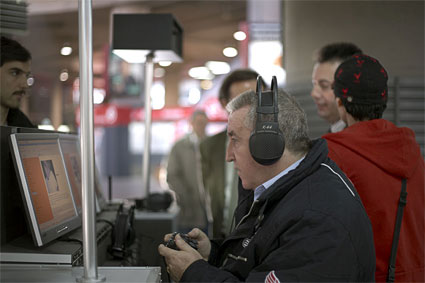
Burn Station
With the motto “taking the Internet to the streets” and inspired by the way the web works, Platoniq explores new models to distribute, shape and share information, knowledge and cultures.
At the Banquete_nodos y redes, an exhibition that recently opened at LABoral, Platoniq was presenting Banco común de Conocimientos[BCC] (Bank of Common Knowledge), a kind of lab platform that engages with new ways of enhancing the distribution channels for practical and informal knowledge.
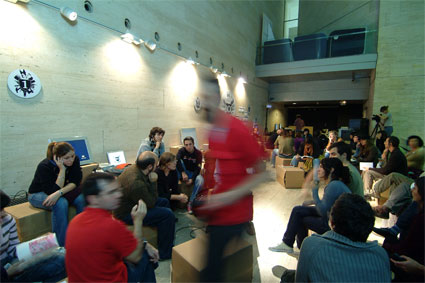
BCC in Barcelona
Inspired by an Internet shaped by the collective effort of thousands of distributed agents who publicly shared their knowledge to achieve a common goal, the BCK project is based on the firm belief that creating, sharing, transmitting and exchanging knowledge in the public sphere is a key element to the growth and development of our societies.
The Bank of Common Knowledge exports the dynamics of Free Culture and the Copyleft philosophy to general processes of knowledge generation and transmission among citizens. Work processes and methodologies are researched while the production of content, mutual education and citizen participation is carried out for the purpose of giving free access to the knowledge generated by the communities in which the Common Knowledge Bank is installed.
For more details, check the video presentation:
After having seen the Bank of Common Knowledge project at the Banquete_nodos y redes exhibition, i thought “hey, look! here’s a fantastic opportunity to ask these guys a few questions!” And here i am:
You set up a BCK-2008: Free Knowledge Market last March in Barcelona. How
did the whole experience go?
Actually, we’ve already set up 4 free knowledge markets (this was the second one in Barcelona) during the last two years of the Bank of Common Knowledge development. Previously we also had built BCK’s active nodes in Cambridge UK (Wysing Arts Centre) and in Lisbon, both ending up with the open organisation of a market.
The last Bank of Common Knowledge happened in Barcelona in April. Exchanges of knowledge took place in 3 spaces with the help of 80 volunteers.
The Bank of Common Knowledge Markets are made possible through the offers and requests that BCK receives from citizens: How does a consumer cooperative function?, How can i share wifi with my neighbours?, Is it possible to earn money through collaboration instead of competition?, Is it possible to unfreeze patent-protected scientific knowledge? What can we learn from traditional cultures in the economic context? How can we regularize immigration documents in Spain? How can we set up a wiki without computer?
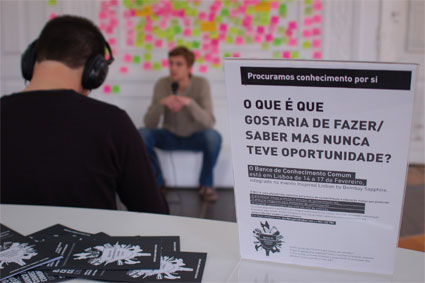
BCC Lisbon
The Market of the Bank of Common Knowledge attempts to cover a wide range of topics and materialize them through free workshops and manuals for urban survival. A gathering of transgressive and generous experiences by individuals and communities who put into practice various forms of autonomy in daily life.
Those exchanges are recorded and published online under a copyleft license in order to guarantee that knowledge keep on circulating.
Besides, experimenting with new forms of participation and organization is fundamental for BCK. The BCK organization is always open and follows dynamics made of cooperation, documentation of the whole process and a responsability distributed among all the persons involved. Anyone interested can participate to BCK, either by joining the internal organization, or by offering or requesting knowledge or even by helping us produce contents to be distributed online.
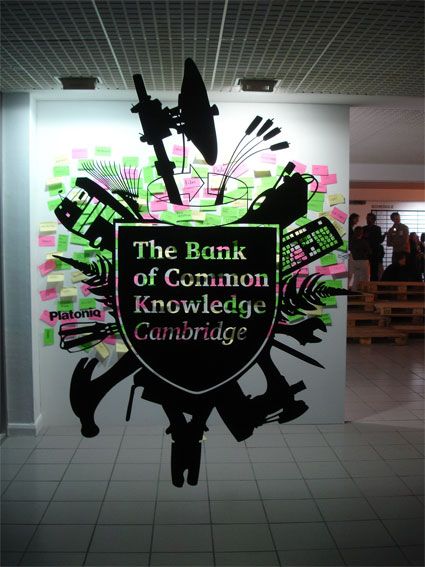
BCC in Cambridge
The first days of exchange took place in November 2006 in Barcelona’s CCCB cultural center. Then in 2007 in Cambridge and more recently in Lisbon.
The main topics we focus on are:
EDUCATION (P2Pedagogy)
Experiments in the transmission of knowledge.
Generating educational methodologies and systems which augment the possibility to turn each moment of one’s life into an opportunity to learn.
ECONOMY
Models of auto-management of cultural projects. Exploration of economic systems sustainable for free culture.
ECOLOGY OF KNOWLEDGE
Going beyond the creation of free contents to engage also in strategies of exchange and recycling of knowledge in danger of disappearing.
PUBLIC SPACE
Investigating the various use of public space related to the transmission of knowledge. Exploring the existing possibilities to use public space for collective activities of exchange (guide of places and actions required to be able to use them).
CITIZEN RIGHTS
What are our rights, what can we do in case of abuse, experiences of communities who work to improve life in common.
Video of the Cambridge’s market:
Video of Lisbon‘s:
How receptive is the general public to the concept and opportunities offered by BCK? Or is it mostly the “creative commons” crowd who is enthusiastic about the project?
The copyleft and the free culture crowd is naturally more receptive to the BCK project and to horizontal dynamics of knowledge sharing. Nevertheless, in order to make the free culture not only free, but public, the main objective of BCK is to apply the positive effects and strategies of the free software movement and p2p systems to the areas of education and citizen participation, setting free the full potential of individuals and collectives through self-determination, autonomy and infinite networking.
BCK is organized as an open source model of knowledge transfer, a laboratory for inventing and trying out new forms of production, education, organization and distribution, involving new roles for producers and receivers, experts and amateurs, teachers and students…
Again, anyone interested in taking part in the BCK’s internal organization structure (teams) is welcome to do so.
Right now we are working on several strategies to lay the foundations of this mutual education network, offering every individual the chance to share their current interests with other, similarly motivated peers in the fields of ecology, technology and communication, alternative economies, civil and human rights, public space use or any knowledge to make life easier and more autonomous.
We are currently testing various knowledge transmission and communication formats, such as games, demos, workshops, first person experiences, challenges, first aid kits or take away theory. These activities are documented in a set of video manuals or knowledge capsules currently being produced for inclusion in the Bank of Common Knowledge.
However, the main goal of the project is not to build an online video archive, even if that would end up being one of the consequences. The real challenge for the Bank of Common Knowledge is to build a model of transmission and free exchange whose social organization and self-training strategies can be easily replicated.
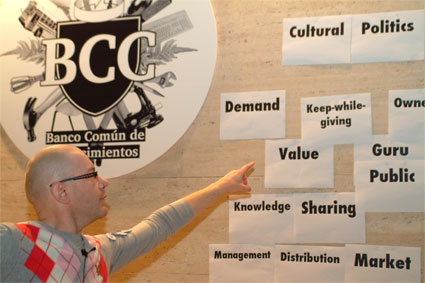
What makes you think that you are on the right path and that the quest for a free exchange of knowledge is more than an utopia (that’s my pessimistic and cynical side speaking here)?
BCK is one of the many projects that has emerged of a society where peer production and peer governance present new opportunities for individuals and groups to create value together. We try to place these new developments in both a historical context and a future oriented context. This is no utopia anymore, copyleft and the sharing of knowledge is a functional revolution.
Regarding feedback, after a long year of development, traveling, meeting people, giving workshops about BCK in different countries during the last year (lastly in Shanghai, México City and Casablanca where a node is under construction) made us realize it would be more than useful to produce a BCK manual focusing on how to build/organize/sustain local Banks of Common Knowledge, or any collective production/trading community on the basis of our experience and the experience of others. This is actually the most frequent demand to the Bank of Common Knowledge.
To fulfill that demand, we’re actually developing a set of exercises/manuals which explain and apply methodologies and ethics of social and free software to social community building, looking at “atomization” of knowledge and civic participation on the basis of P2P networks and protocols. So this is clearly about P2Pedagogy.
All these games/exercises are performed offline, although they are inspired in social software and social open networks functionalities, their aim is clearly to help people to understand, practice, decide, find their own protocols of networking and encourage civic engagement and community building/sustaining. An example of it is the social tagging game we presented at LABoral, which is about applying folksonomy to offline social networks using post it notes.
The main questions the games and BCK itself try to resolve are:
Suggestion or main questions to resolve:
Atomization on a large scale (such as in the Debian APT package manager or the CVS version control system) has allowed large software projects to employ an amazing degree of decentralized, collaborative and incremental development. But what other kinds of knowledge apart from software can be atomized, and how?
Does atomization kill community?
How can we formally translate Ubuntu‘s like project governance in social and public space? How can we explain notions such as decentralized budget, decentralized trust etc and other human protocols that sharing and peer production involves?
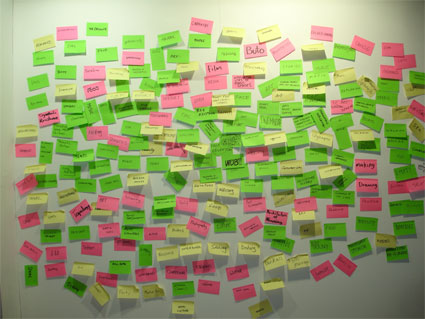
Among the first public actions that BCK undertook over the years 2006 and 2007, the Platoniq group launched a research project that looked for new perspectives which would enable, on the one hand, broaden the network of BCK collaborators and, on the other hand, improve and stimulate the development of its structure, content, strategies of dynamization or the economical sustainability of the initiative, the same way one would do during the beta testing process of a software project.
To achieve this objective we entrusted several experts with a series of exercises/games that allowed the simplification of ideas, strategies and concepts related with the various technological protocols and philosophies that form the basis of the Bank of Common Knowledge, in an attempt to communicate it to a non-initiated public. Among this group of experts are the researcher Ismael Peña Lopez, Juan Freire (biologist and hyper-active blogger who explores the interaction between urban space, social networks and digital spaces), Michael Linton (creator of the mythical LETSystem in the ’80s), Gregor Gimme, one of the initiators of the online community for video learning Sclipo, Enric Senabre (technological coordinator of the Observatorio para la CiberSociedad), Dmytri Kleiner (polemical leader of Dialstation, a project of “venture Communism”), or the sociologist, biologist, economist and expert in barter networks in Latin America HeloÃsa Primavera.
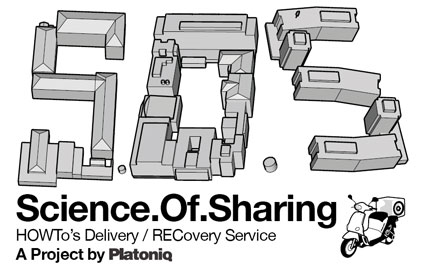
The S.O.S. project
Now a question about a project which was not exhibited at LABoral but which
i nevertheless find intriguing. The S.O.S. project is a kit to communicate
and exchange knowledge in public and private space inspired by the Speaker’s
Corner. How did you use this kit and how did people react to it? Which kind
of situation did it give rise to?
Actually The S.O.S (stands for Science of Sharing) project is still under heavy development. It hasn’t been tested on the streets yet. We plan to release both a software and a mobile unit which are the core of the project during a set of actions due to be held next autumn in various middle sized cities of Catalunya.
The kit contains a battery-powered sound system with microphones, a computer and an FM radio transmitter, mounted on a scooter that will serve as a ‘knowledge delivery / recovery service’ to facilitate temporary knowledge-exchange actions.
In a few words, and to maintain suspense till the autumn, the S.O.S project seeks to adapt the techniques of peer-to-peer media sharing to collaborative, peer-to-peer education, allowing discrete chunks of information to be broken down and passed on via a network of volunteers, this is about atomisation of knowledge and atomisation of the city. S.O.S is an analog tracker, connecting peers and seeds, reclaiming public space 2.0 of the knowledge city
S.O.S will be the result of the lessons learnt with the BCK project, as well as four years of public domain research and development, working on the burn station project, a free software-based open source project, that seeks to generate an alternative model of production and distribution of copyleft music in the public space.
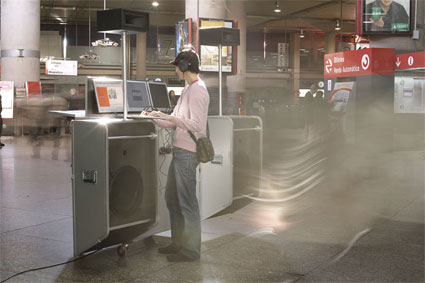
Burn Station
In the case of Burn Station, the objective was to put in practice a 100% collaborative system based on three interacting communities: net labels and artists that feed the database, software developers and groups administrating local Burn Stations. An attempt to strategically combine the experience of peer-to-peer networks with the Jamaican sound system culture. (P2P on a Face 2 Face basis)
An important lesson learnt from the BURN STATION software development: test, share and further develop software in the streets before publishing it on the net. It is the best and the most rigourous software testing model imaginable. Definitely inspiring…
Nevertheless, the most interesting thing about Burn Station for us is that it has been autonomously reproduced in schools, social centers, libraries and universities in Europe and South America, demonstrating its value as an educational tool. That’s exactly what we expect to happen with the S.O.S project altough the challenge is more complicated this time because there is no consumerism involved here (free distribution is not enough!), no music involved, just raw production of collective knowledge from scratch. We need to build and drive our own networks! Back to the future of commons!
Video documentation of Burn Station
Other work participating to Banquete_nodos y redes: Sightseeing telescope reveals open wifi networks in urban space.
Banquete_nodos y redes runs at LABoral in Gijón, Spain until November 3, 2008.
From what i can learn from the press we are living in food mayhem: yesterday morning a nutritionist was complaining on French tv that because the country had turned its back on the usual bread and jam breakfast in favour of American-style fat and sugar-loaded cereals, the population was at risk of fattening. In the afternoon, i was reading in La Repubblica that the soaring costs of pasta, bread, fruit and vegetables are making Mediterranean diet harder to afford. Italians are eating more cheap processed foods high in fat, sugar and salt (via WSJ.) The whole continent is complaining about the food crisis. Meanwhile, bananas are dying, eating local might not always be that energy-efficient after all and a livestock meltdown is under way across Africa, Asia and Latin America. An alarming report states that native breeds are increasingly being supplanted by Western farm animals, which may be less well able to adapt to their new environment in times of drought or disease. In Europe, some 98 per cent of vegetable varieties have disappeared over the past century and EU regulations are hastening the decline.
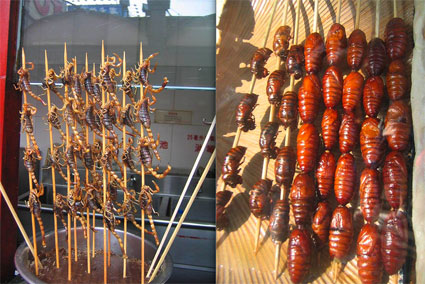
Yummy healthy insecty snack seen in the streets of Beijing
Mind you, researchers have devised new but rather unappealing ways to have us enjoy food like never before: fish are being trained to catch themselves, we’ll be able to choose between meat from cloned animals and in vitro meat and encouraged to get better proteins by snacking on insects.
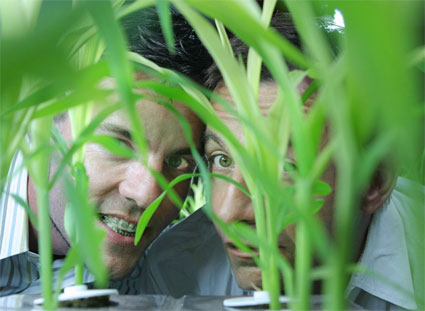
Matias Viegener and David Burns have added the corn issue on the table.
You might know them for their ongoing collaboration with Austin Young: Fallen Fruit, a project which encourage people not only to map “public fruit”, fruit which grew on private trees and fell on public spaces, but also to harvest and plant fruit parks in under-utilized areas.
Back in 2004, Matias and David worked on an installation which i discovered only recently. That year, Fritz Haeg (of the Edible Estates fame) and Francois Perrin produced and curated the GardenLAb experiment. Set in a 1942 supersonic wind tunnel, the event explored the relationship Los Angeles residents have with their environment by experimenting and speculating on current and future ecologies.
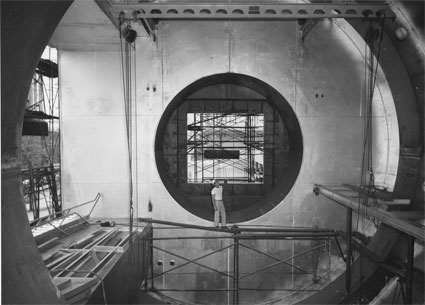
The “Coop Wind Tunnel”
Corn Study humourously addresses the future of human food production and the ongoing consequences of issues that range from the latest developments in genetic manipulation, mistreatment of plants and animal species, corporate control and profit motivation, diminishing genetic diversity, modification of our ecosystem, privatization of ownership of plant’s genome, etc.
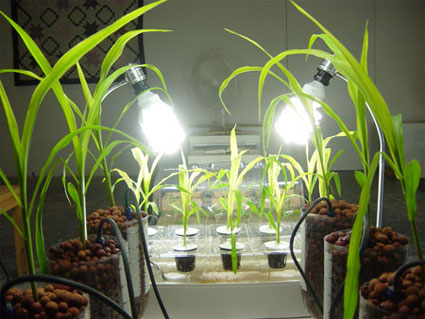
Corn Study, detail (Figure 0038), 2004. Photography Austin Young
One of Corn Study’s objectives was to develop a new relationship with the corn species.
Through the use of audio and autosuggestion the artists deployed Aldous Huxley‘s theories of hypnopedia: the most powerful educational device being unconscious suggestion to the embryo to maximize its developmental potential.
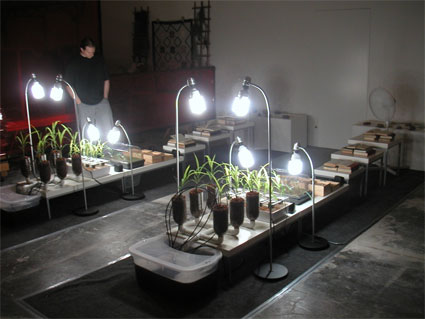
The school is set up on ten tabletops with different learning stations, with the corn seeds learning through audio speakers as well as by the use of electric fans behind a row of books, which carry knowledge through the air like pollen. In this program of accelerated learning, the individual kernel is not expected to learn everything — the species as a whole will absorb the knowledge collectively. The variety of knowledge bases is hoped to heighten the corn’s wisdom, especially since despite their enormous acquisition of knowledge, humans have acquired so little wisdom.
As the artists conclude in their presentation of the project: While it may take many generations before the outcome of our experiment can be demonstrated, we are hoping for positive mutations and raised consciousness in the corn, to be passed along to other species. At this stage of global development, humans can no longer be entrusted with full stewardship of the environment. Perhaps if other species can intervene, they will do a better job.
I asked Matias and David to tell me more about the school for corn species:
We’ve been hearing and reading about genetic manipulation for years now. I sometimes think that consumers got used to it, accepted the idea and wouldn’t mind buying and eating GMO (or even cloned meat when it lands in our supermarket fridges.)
What exactly should we be worried about? What is different in the new forms of manipulations Corn Study comments on?
While we were interested in genetic manipulation we wanted to work away from it. The basis of Corn Study was the idea that corn had been studied and manipulated more than any other plant than perhaps soybeans. While we’re disinclined to GM foods, it seems clear that all our agricultural foods have been manipulated for millennia. So we wanted to refocus the question of GM foods into the broader question of how humans have studied and changed our foods without any seeming consideration for the nature (or the education) of the foods themselves. What if we could give the corn some agency of its own, educating it about its human hosts. Our ironic goal was to find a way for the corn to gain some power over its own fate, to “speak out” if it could, by learning more about us and both the good and the bad of the human universe.
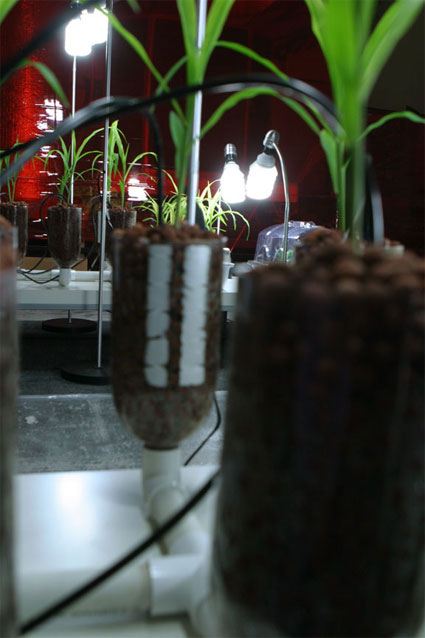
What does corn education involves exactly? Could you guide us through the whole curriculum?
While there was a lot of specific material, there was no defined curriculum for the corn school. Or maybe a better way to say this is that we could have endlessly kept adding educational material to the school. Here’s a quote from the original text that was distributed to visitors:
“The curriculum is composed of texts, lectures and readings in political science, history, psychology, philosophy, foreign languages and cultural studies; we have tried to select materials that help outline the background of our global socioeconomic, political and environmental circumstances. For the student’s personal growth we include tapes on self-actualization, meditation, hypno-suggestion, and personal dynamics. The songs are mostly pop music from the 60’s and 70’s, chosen to reflect the optimism of a time now fallen by the wayside. Included in our coursework are Noam Chomsky, Friedrich Nietzsche, Marxist theory, Mahatma Ghandi, Winston Churchill, Neil Armstrong, Machiavelli, Plato, Immanuel Kant, Abraham Lincoln, Anthony Robbins, Brian Tracy, Zig Ziglar, Lao Tzu, Gloria Steinem, Elizabeth Vandiver, greek myths, Howard Zinn, Ken Wilber, Malcolm x, Michael Moore, Ralph Nader, Lyndon B. Johnson, Al Sharpton, Terence McKenna, Aldous Huxley, Paul Scheele, Michael Pollan, Henry Thoreau, various international Pimsleur language audiobooks, The New Christie Minstrels, Melanie, Paul Williams, Ray Charles, The Carpenters, Cher, Three Dog Night, The 5th Dimension, Donovan, Bread, Dolly Parton, Jefferson Airplane, Sly and the Family Stone, the Doors, and John Denver.”
Do you welcome both “natural” and modified corns in your classes? Is there any segregation?
We welcomed all corn to the school, including GM corn. We tried for a good mix of modern hybrids and ancient or “heirloom” corn varieties. We don’t think one group is in any way superior to the others. The idea was to empower the species as a whole to make collective decisions and perhaps take actions to both improve their lot in the world and deflect any more human mismanagement of it. Halfway through the design we realized that all seeds of all species should be welcomed to the school, without distinction between crops and weeds, the good or the bad, which are all values that come from humans and not from nature itself.
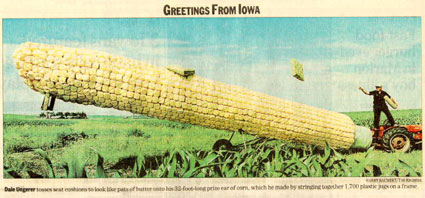
Giant Iowa corn
Why did you choose to work with corn? Wouldn’t animals seem like a more natural and rewarding choice?
We worked with corn because of the place it holds in American culture. Americans consume more corn products than any other nationality (and in recent years corn has been blamed for a host of our health problems.) We love animals but this sort of project was hard enough to mount with the immobile corn plants… it’s hard to think how we would have done it with a herd of cattle.
I read that plants communicate. Do you expect your corn students to spread their newly acquired knowledge to their companions?
It’s certainly possible for plants to communicate, and perhaps we succeeded in communicating with them, and that our ideas got passed along the botanical spectrum. Of course the real audience for Corn Study was human. We felt that in addressing the corn, the humans might consider seeing the universe from a less human-centric position. Just as we have no preconception about how these ideas would flow through to the plants, we were very open to how they might arrive to the human spectator. A key to our work here is the use of play combined with what we think of as vital issues of our times. Much of our work plays on corniness as a way to be serious, on the relation between pure, purposeful aesthetic or cultural ideas and the low, foolhardy kitsch of the ordinary world. We’re not interested in art that’s pedantic, but we do care about conveying ideas and questioning values. We’re not especially interested in art that creates objects either, but we are invested in the way in which artmaking expands the variety of containers for ideas (and can make things in general look nicer).
Thanks Matias and David!
All images are from the installation at GardenLAb.
Related: Nigel Helyer´s Host, in which an audience of several crickets attend a lecture concerning the sex life of insects and Aron’s School for Frogs.
It’s not everyday that Dick Cheney gives its title to an art exhibition.
In the weeks following September 11, the U.S. Vice President justified a steep increase of surveillance measures by explaining that “Many of the steps we have now been forced to take will become permanent in American life. They represent an understanding of the world as it is, and dangers we must guard against perhaps for decades to come. I think of it as the new normalcy.” Almost 7 years later, the collection and sharing of personal data by governments, luggage searches, Internet monitoring, and wiretaps have indeed become part of a “new normal” in American life.
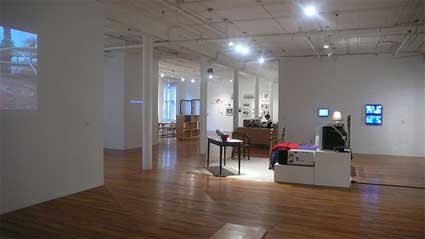
View of the exhibition space
The New Normal brings together thirteen artworks which explore private information. All the works have been developed after 2001, the year that ctrl[space] : Rhetorics of Surveillance, a major exhibition on privacy and surveillance opened at the ZKM center in Karlsruhe, Germany. It’s not a redux of the exhibition: new factors have changed the surveillance panorama since the ZKM exhibition opened. There’s President Bush signing the Patriot Act on October 26, 2001, the number and efficiency of technologies of surveillance have skyrocketed and we have come to accept the new state of “normality”.
The New Normal reveals how difficult it is to set clear boundaries around the concept of privacy. The private sphere encompasses domestic spaces, personal data, the content of your pocket, bodies, thoughts, communication, and behaviors–contexts that are usually rendered inaccessible to the public eye by legal, social, and physical boundaries.
What is most remarkable about the show is the subtle way it engages with the complex concept of privacy. The videos and installations do not hammer their messages on your head, you’re not told what to think and what to be very afraid about. Instead, the exhibition argues that today’s society is indeed living Cheney’s new normal life but this doesn’t meant that the new condition of public disclosure cannot be harnessed in the service of artistic endeavours and the creation of “tactics for political critique.”
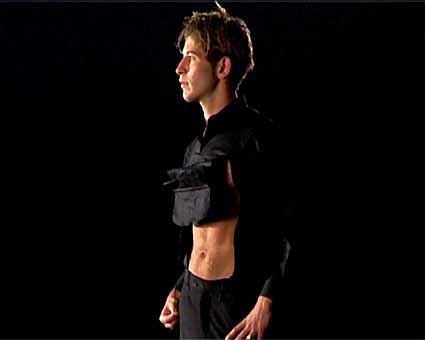
Videostill
Submitting oneself to security measures can be turned upside down by adopting what Hassan Elahi calls an “aggressive compliance”. Elahi daily points a mocking finger to absurd security measures with the real-time self-tracking website he set up in a bid to demonstrate to the FBI investigator that he’s not spending his time traveling to the Middle East and plotting some attack in the U.S. The models features in Sharif Waked‘s Chic Point Fashion for Israeli Checkpoints video seem to have adopted a similar strategy.
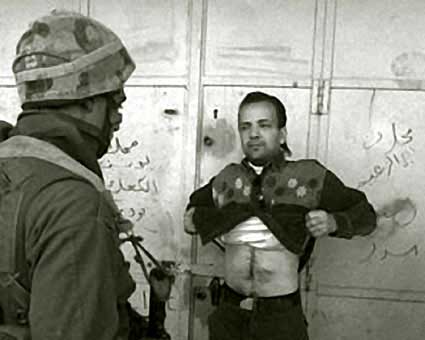
Videostill
Sharif Waked’s video features male models catwalking in clothes designed to expose the flesh of body parts such as chests and abdomens. It would be hilarious and cheeky were the images not juxtaposed with stills taken from recent years displaying Palestinian men having to lift their shirts, take off their pants and kneel shirtless in order to be authorized to cross Israeli checkpoints. The absurd pieces of clothing evoke the bodily humiliation experienced by Palestinians at Israeli checkpoints.
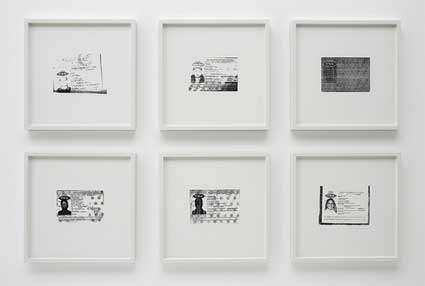
Six CIA Officers Wanted in Connection with the Abduction of Abu Omar from Milan, Italy. Courtesy the artist and Bellwether Gallery, New York
Equally politically-loaded is the series of badly photocopies of passports of CIA agents researched by Italian authorities in connection with the abduction of radical Egyptian cleric Abu Omar. On February 17, 2003, Abu Omar disappeared off the streets of Milan. The man had been kidnapped by the CIA, transferred to Cairo, where he was secluded, interrogated and allegedly tortured and abused. He was released 4 years later. The Imam Rapito (or “kidnapped Imam”) affair prompted a series of investigations in Italy.
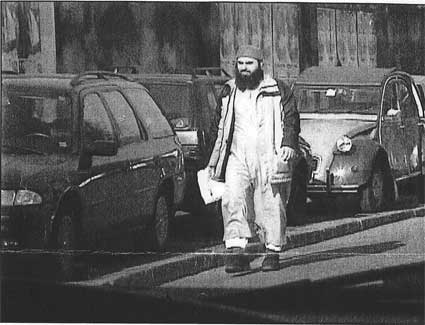
Twenty-six Americans were submitted to a trial in absentia along with several former Italian intelligence officials for their role in this case of extraordinary rendition. Trevor Paglen managed to get a copy of the photocopy of the fake passports that the agents had to deliver while they were checking in posh hotels in Italy in preparation for the kidnapping. The documents were released by Italian prosecutors in 2005. Although every element appearing on the identity document is fake, the picture had to be authentic. This ensured that the cover of the agents was blown and that the surveillance tools used by a government to achieve questionable goals can also become an instrument of justice.
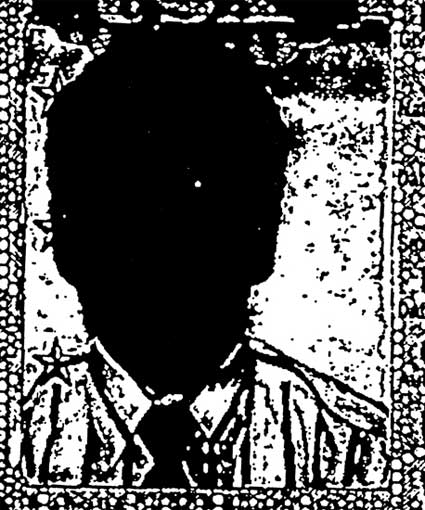
James Thomas Harbison (CIA Officer Wanted in Connection with the Abduction of Abu Omar from Milan, Italy). Courtesy the artist and Bellwether Gallery, New York
Relationships feed on bits of private information, it’s a currency we exchange with other people. Jill Magid‘s performance, photos and video Lincoln Ocean Victor Eddy not only illustrates this concept but it also put a human face on the surveillance we are submitted to every day.
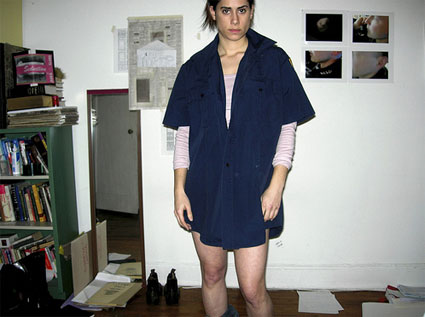
Jill Magid, His Shirt, Cropped (from Lincoln Ocean Victor Eddy), 2007. Courtesy Yvon Lambert Gallery, New York.
Back to New York City after five years spent in The Netherlands, Magid kept hearing this announcement in the subway “You may be a subject to searches “for security reasons”.” She approached a police officer and asked him to search her. He refused because only women officer had the right to search a woman but she managed to convince him to call her and tell her each night where he was on shift. She’d join him to be “trained” and kept record of the meetings in different forms: diary (read excerpts), photos, objects, etc. He would lend her his duty shirt, she’d give him a picture of her wearing it in return. She makes him tuna sandwiches, one day he allowed her to hold his gun. The relationship they build bit by bit is both intimate and somehow doomed: they are so different, the officer has never been to an art museum, Magid is “one of those liberals”.
Several works show that the intrusion into the private sphere is not just made of CCTV systems and biometric apparatus, it can also be voluntarily self-inflicted now that new online platforms called blogs, Facebook and image sharing call for self-disclosure.
As curator Michael Connor writes, Private information has never been less private.
The best example of this is probably the collection of videos that Guthrie Lonergan archived on you tube under the title MySpace Intro Playlist. Although they were made to be viewed by others, they convey an embarrassingly intimate echo once they have been decontextualized and exhibited in an art exhibition.
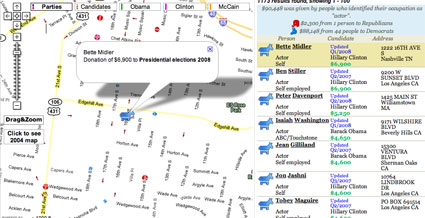
Developed by Michael Frumin during the 2004 Campaign in the U.S., FundRace is back. The website maps donation made to the candidates of the Presidential Election in the U.S. and enables you to search by name or address to see who your friends, co-workers, and neighbors are supporting. You can also search by profession and discover who celebs and museum curators are donating to.
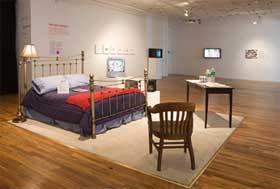 The revelation of famous people’s private requests almost makes you say thank you for a society which is so obsessed by the mundane facets of celebrities. Jennifer and Kevin McCoy‘s contribution to the exhibition is part of a series of sculptural displays of the products that musicians contractually require to be present in their dressing rooms after a performance. That’s where the loop closes and we get to cross path with Dick Cheney again. Band Rider Series (Dick Cheney) gives a glimpse into the very lack of spectacularity of Vice President’s desires when he travels to a new venue to give a talk: all tv sets have to be turned on FOX news, the hotel restaurant menu must be in his room along with bottles of water, etc.
The revelation of famous people’s private requests almost makes you say thank you for a society which is so obsessed by the mundane facets of celebrities. Jennifer and Kevin McCoy‘s contribution to the exhibition is part of a series of sculptural displays of the products that musicians contractually require to be present in their dressing rooms after a performance. That’s where the loop closes and we get to cross path with Dick Cheney again. Band Rider Series (Dick Cheney) gives a glimpse into the very lack of spectacularity of Vice President’s desires when he travels to a new venue to give a talk: all tv sets have to be turned on FOX news, the hotel restaurant menu must be in his room along with bottles of water, etc.
THE NEW NORMAL is a traveling exhibition co-organized by iCI (Independent Curators International), New York, and Artists Space, New York. It is on view at Artists Space until June 21, 2008.
Hasan Elahi at The Colbert Report:
Related: Sousveillance culture, Orwellian Projects, Book review – ctrl[space] : Rhetorics of Surveillance, Transmediale exhibition: Conspire, Trevor Paglen’s talk at Transmediale, etc.
Heidi Kumao‘s art pieces explore ordinary social interactions in order to reveal what lies beneath them: psychological states, emotions, compulsions, thinking patterns, and dreams. She is currently teaching animation, video, experimental television production, and electronic and conceptual art at the School of Art and Design at the University of Michigan, Ann Arbor. For 2007-08, she has been awarded a Postdoctoral Research Fellowship from the American Association of University Women Educational Foundation.
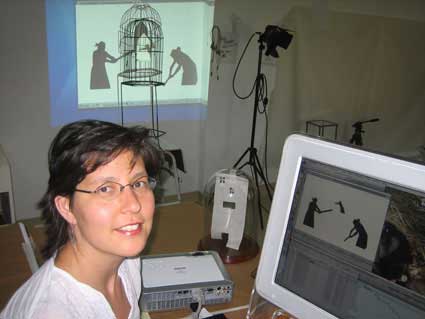
A few years ago i discovered her set of female kinetic sculptures “Misbehaving: Media Machines Act Out,” and classified her work under robotics and kinetics. Then i stumbled upon the performative techno-enhanced series of clothing she had developed and here i was trying to fit her work inside the “wearable” category. A closer look on her portfolio revealed household objects sabotaged to become cinema machines, overtly activist projects and the geekiest wedding cake i had ever seen. The experience taught me that any attempt to classify of her work would be pure folly unless i’d try to trick her into giving me a helping hand:
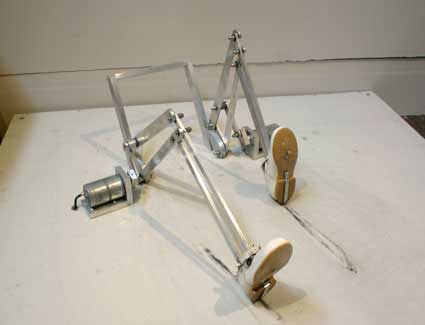
Resist, 2002
You first graduated in photography at the School of the Art Institute of Chicago. How did you come to work with kinetic installations, RFID activist projects and quirky wedding cakes? What made you broaden the scope of your artistic practice?
This is a big question, so I’ll answer it in sections as a way to answer the larger issue of shifts in artistic practice. How I get from here to there to there to there…
Re: transition from photography to sculpture
The Art Institute had a very interdisciplinary photo department at the time and we were really encouraged to “go outside the box” of photography, to mix photography with other media, to be artists who USE photography rather than pure photographers. In the 80’s and 90’s, photography was exploding in 100 different directions and open to a variety of approaches. Everything was possible. Everything could be photographic in some way.
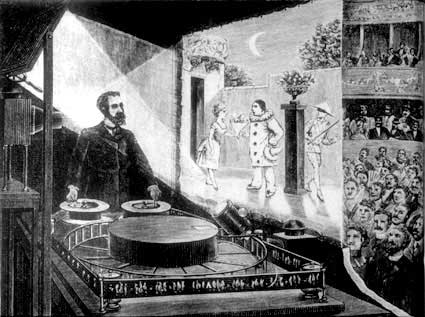
When I entered graduate school as a photographer I was already starting to work with sequential imagery. I was driven by a need to animate physical gestures and behaviors as indicators of psychological states. Simultaneously, I was collecting domestic objects and record players and researching pre-cinema devices and the 19th century creation of spectacle, Emile Reynaud‘s praxinoscope from the 1880’s, in particular. My first kinetic works were homemade-looking zoetropes that projected a sequential loop of 12 images: a child being spoon-fed, a woman’s legs curtseying, a woman frantically sweeping. Like a memory that can’t be repressed, each animated sequence repeated endlessly and mechanically. In this way, each object seemed to be speaking with its images, a visual and mechanical voice replacing text. Much like the girls’ legs I made much later, they were an artificial life form, a stand-in for a real person that I could construct and bring life to. These “cinema machines” (as I called them) allowed me to combine all of my interests (photography, performance, sculptural assemblage and the psychology of everyday life), into one art form. I loved working this way and continued to create cinema machines for several years.
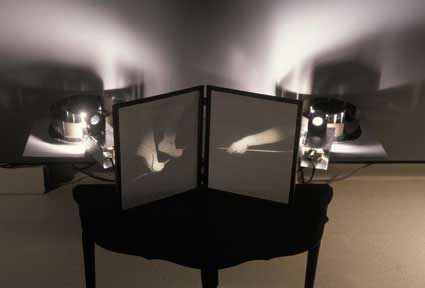
Defense Mechanism
RE: Installation
While much of my work could be categorized as “kinetic installation,” a more accurate descriptor might be “animated tableau.” I tend to think of myself as a theater director, staging events for the viewer. A lot of my art practice is about creating a situation for something to unfold over time. This grew organically out of my experience staging photographs. It seems to be a mode of art making to which I am intuitively drawn.
Each tableau intentionally uses recognizable objects that suggest a possible scenario from everyday life. As I craft each piece, I am very conscious of the psychological experience that is created for the viewer. Can the space of each tableau imply both a physical site and a psychological state? How can I make the viewer re-examine seemingly ordinary events such as childhood play, family dynamics, television news or even the wearing of clothes?
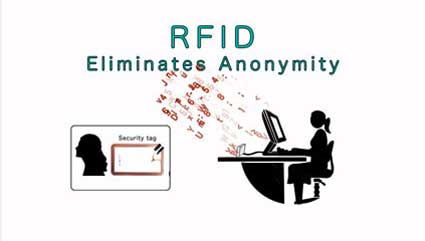
Still from Zapped! video
RE: RFID Activist projects
I worked on Zapped! a multi-part project about the mass implementation of RFID technology with Preemptive Media in 2005. I met the members of Preemptive Media (Beatriz da Costa , Jamie Schulte, and Brooke Singer at Carnegie Mellon University in Pittsburgh, PA where I was a Microsoft Artist-in-Residence Fellowship for 1999-2000. Besides being a great school for robotics, computing, AI, engineering and art, Pittsburgh happened to be an amazing hub for art collectives, tactical media practitioners, and technological art at that time. I was surrounded by tons of brilliant people including folks from Critical Art Ensemble, Institute for Applied Autonomy, and Subrosa, to name a few. Just being in this environment made me rethink my artistic process completely, and motivated me to learn how to incorporate electronics, microprocessors, computing, and digital imagery into my work.
Before we ever did Zapped! a few of us had collaborated on a project (Nomadika) about data-veillance and wireless technologies for the 2001 Sculpture Conference in Pittsburgh. We educated and informed the public about the future of data mining by opening a storefront for our fake marketing firm. Researching data mining and privacy loss in our contemporary era later led Preemptive Media to the project on RFID, which seemed to be (at the time) yet another way in which corporations and the government would invade citizens’ privacy. As someone who creates and teaches animation and video, my primary role in the collaboration was to make the educational video from all of the research and information we had unearthed as a result of this project.
After working solo for so long, I relished the opportunity to collaborate with others on a project.
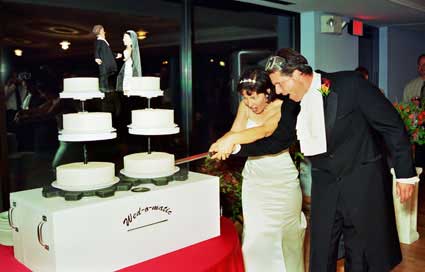
RE: quirky wedding cakes
The 6,000 volt wedding cake was a collaborative project with my husband, Michael Flynn, a high school physics teacher and science exhibit designer. As two mechanically minded people, we decided that our cake had to reflect our interests in machines and the project grew from there. It started with the idea to have two cakes cut to look like interlocking gears and progressed to two motorized cakes on gear-run platforms. Michael made two dolls that represented us in our wedding costumes. These dolls were going to stand on the top of each cake and would basically pass one another every time the cakes turned. Eventually, I thought we needed to incorporate an electric “spark” between the dolls, like the “spark” between us (cheesy, I know). This led to the idea of using a Jacob’s Ladder to generate a much larger spark. Michael purchased a neon sign transformer and wired the cakes and dolls with opposing charges. When powered on, the cakes turn, and once a turn, the dolls hands meet and a large flaming spark erupts from their meeting hands. It’s pretty funny. And like other collaborative projects I’ve done, it was loads of fun!. Our “how to” article appeared in Make Magazine.
What made you broaden the scope of your artistic practice?
When I look over the various transitions I have made with respect to media
(from photo to cinema machines to kinetic sculptures to animation to collaborative technological projects), I can map those changes onto personal and cultural moments of change. For many years, I made a life as an artistic nomad. I relocated every year or two for jobs, fellowships or other opportunities. This experience of having to re-contextualize and refocus myself in so many different places shaped my art practice in a deep way. Each time I moved, the new school, city or community raised new issues to consider. For example, (like I said earlier) as a research fellow at Carnegie Mellon, I was exposed to art practices that critically engaged technology rather than simply used technology. I had access to people, tools, and resources such as machine shops for the creation of custom parts, computer programmers, robotics labs, video editing equipment, etc. As a result of being at Carnegie Mellon, my work shifted away from more personal themes towards more political issues and cultural critique.
While I had been using technology for many years, my time at CMU caused me to rethink how I used it and why.
Exposure to such a large computing environment had other long-term effects on my art that didn’t show up until much later. Researchers in AI, computing, robotics and gaming exposed me to the possibilities of generative artwork, which was a complete paradigm shift from creating “fine art” objects for the art world. I was excited to think about making a dynamic system or a tool as an artwork rather than a fixed object. However, it took me awhile to decide on a project that would best be served by this approach.
Later, when I moved to Ann Arbor, Michigan, 9-11 and the proliferation of cable news caused me to analyze the visual and conceptual construction of the news broadcast more critically. CNNplusplus, an interactive and dynamic news broadcast, was born a few years later (in collaboration with Chip Jansen.
Video:
The short answer to your question is simply new places, new people and A.D.D. or the tendency to get bored easily…
You seem to navigate effortlessly from one discipline to another but are there particular issues or elements that you keep returning to?
Yes! I find that I return to an exploration of ordinary social interactions and their psychological undercurrents, institutional critique (mainstream media, traditional gender roles, others), and performance (creating theatrical spectacle, behaving/acting social roles, performing for a camera). I view performance as an integral part of everyday experience and define it very broadly: as a means to define our identity and sexuality, as an examination of roles we play as employees or family members, and as a tool for self-expression. Every piece has its origins in everyday life: an argument, a memory of childhood, the frustrations of watching television, the act of being a consumer–
My art making process is grounded in these types of experiences.
Combining these three things together has produced two main types of work that are pretty different (at least to me):
1) Work that emphasizes a visceral experience and tells a more personal story: the “cinema machines,” the girls’ legs, stop-motion animations, and my latest shadow theater pieces
and
2) interactive projects that are more overtly political and use technology to critique technology: CNNplusplus, Zapped!, Wired Wear
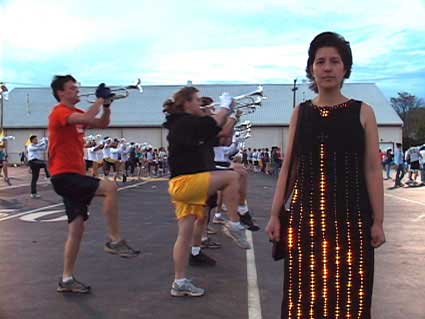
Monitor II: Audio-activated Dress, 2005
I find I am drawn to the more personal works because they provide an outlet for me to imply/suggest a critique of institutions of power without being so literal. Almost every piece starts with a personal story of some kind and the creation of a tableau is an opportunity to create a visual poem of images and objects together. By exposing the physical apparatus that drives the bodies into action, I draw a parallel between this machinery and the mechanisms of our unconscious: defense mechanisms, sex drives, thinking patterns, self control, dreams, impulses, instincts.
With the public/interactive projects, the emphasis is more educational and/or ironic. Working collaboratively removes the personal emphasis and creates opportunities to address larger cultural issues and their effects on the general public.
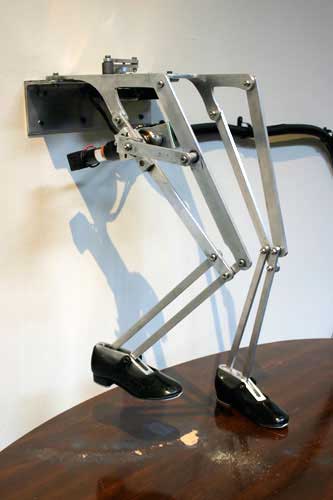 Misbehaving is a series of three female “performers” for intimate installations. What is the performative part of the work?
Misbehaving is a series of three female “performers” for intimate installations. What is the performative part of the work?
Misbehaving consists of three pairs of aluminum, mechanized legs fitted with girl’s shoes: Protest, Resist and Translator. The legs in Protest stomp loudly and unpredictably while standing on a coffee table. In Resist, a pair of girl’s legs squirms on the floor in a way that is both sexualized and challenging in response to viewers’ speech. The girl in Translator is trapped on a track between two “adult” chairs with video projectors for heads. As viewers hand crank her from one side to the other, she becomes like a child caught between two feuding parents, or a political mediator, whose body/screen reveals/exposes the real text of the conversation through non-verbal gestures.
With these pieces, I was thinking about the performance of gender, especially for little girls. We learn what is appropriate behavior so early that it becomes naturalized, we don’t realize that we perform it. In developing these pieces, I wanted to intentionally create girls that perform “badly”, act out, misbehave, or act against type. As machines and girls, these works operate in stark contrast to a culture obsessed with “increasing job performance,” high performance cars, and athletic performance. Their acts of defiance are small, yet powerful, signs of agency.
Videos:
The kinetic girls legs have also some feminist (may i use that word?) undertones. Why is it still important to propose a view on feminism today?
YES, you may (and SHOULD) use the word “feminist.” I consider myself a feminist and I think the stigma around the word (created by conservative males) has (unfortunately) had its prescribed effect of preventing people from self-identifying as feminists.
Those legs were born out of my experience at Carnegie Mellon where I was surrounded by really macho robots: machines that can fight fires or repair a nuclear reactor, robots for combat, robots for Mars, etc. At the same time, television programs were priming the mainstream public for what I call “performative robotics,” including BattleBots and Robo-wars, as vehicles for violent entertainment. With technological art and computing still so male dominated, and the research funding driven by the Defense Department, I do think it’s important to remind ourselves that robotics has a range of applications that are social, psychological, poetic, beautiful, and quirky. Are those feminist, or just alternatives to the mainstream?
I think it’s important to maintain a vigilant feminist critique of the world in the same way that it’s important to be vigilant about racism and economic justice.
A couple of years ago you developed Zapped! together with the other members of Preemptive Media. The work examines the mass deployment of Radio Frequency Identification (RFID) and its effects on our everyday activities. At the time the website of the project said that “RFID is not yet a household name or a pervasive technology, but Preemptive Media predicts that everyday encounters with this technology (whether known or not) will soon be commonplace.” How much has changed ever since? How much is the public aware of the possible downsides of RFID technology?
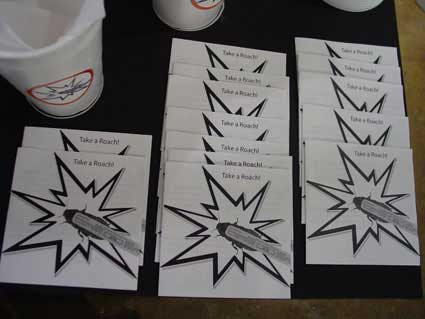
In October 2006, the US started issuing passports with RFID chips that include a digital photo and all other information currently printed in passports. These passive tags in passports are only a small beginning of all-around use as they can be embedded into nearly everything you buy, wear, read, or drive. At the time we did the piece, there was a common fear of surveillance–that by carrying items with tags, you could be tracked, your personal data could be compromised, etc. The reality is that the tags need to be scanned at such a close proximity (a few millimeters) that it’s difficult for someone to scan your item without your knowledge. Plus, if all the tag has is a reference number (for another database) rather than concrete data, there isn’t much to gain by secretly scanning…In general, as with so many of these new technologies (GPS, for example), people choose convenience over privacy. In our current climate, you can’t have both. We all love the convenience of having a cell phone, even though they all have GPS chips. You don’t hear people complaining about the possibility of being located through triangulation of their cell phone chip. At least not yet. I think that data privacy is the new “civil rights” issue of our time–at least in the US where there aren’t many data privacy laws.

I’ve always been fascinated by the story of the roach release. I saw a brief mention of it a newspaper one day. Can you explain us what it was about and in which context it took place? But also, how did the public react to the idea?
The roach release was but one part of the Zapped! project. The multi-part project included the educational video, a school kit for “arming” yourself against RFID surveillance, the roach release station, and educational workshops. Each of these reached a different segment of the population with the goal of not only informing the public about the technology, but also providing them with means with which they might take action against it.
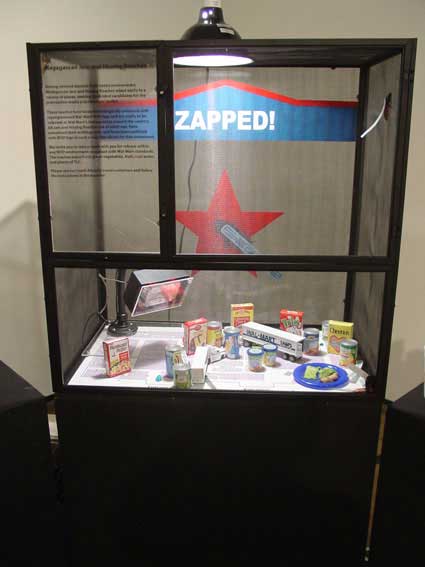
At the time, WalMart was setting the standards for RFID implementation by requiring its top manufacturers to embed tags into the cases and pallets of merchandise. As the largest retailer in the world, its protocol affects the business practice of nearly everyone in merchandising. WalMart pushed for this change touting its increased inventory efficiency. At this point, we speculated that if a WalMart had RFID readers and a corresponding database, they would all be located in the loading dock/storage area of the store. We discussed different ways to use or subvert the signal of the WalMart RFID reader- for passive tags, it sends a small signal in order to read the information on the tag and puts that information into a database. As we went round and round with ideas for tricking/toying with this Goliath, the idea boiled down to creating a small interruption in/jamming the WalMart RFID database. If WE couldn’t gain access to the loading dock and the readers, perhaps we could send a robot, or, as Beatriz da Costa suggested, a rodent or insect in our place. The final solution was to send a cockroach (with an preprogrammed RFID tag glued to its back) into the store’s loading dock area. The RFID tag was programmed with a small text message of resistance–and would definitely cause a “hiccup” in a database that was accustomed to standardized product information. In the video, we gave instructions on how to do a “roach release,” and in Houston (at Diverseworks), we gave away all the Zapped! roaches. I am not at liberties to say anything about the actual release. The public loved the idea and the roach became the project’s mascot.
Video:
Any other Wal-Mart action?
Not with that piece.
What was the impetus for the audio-activated DRESS? How do you exhibit it (or any of your other wearable pieces for that matter)? As part of a performance? As a static piece in a gallery? As a garment you can lend to gallery-goers?
The wearables started as an idea for a fun Halloween costume. I was initially inspired by the humor that could result from providing visual feedback, especially on a woman’s body. The lights on the dress light up incrementally, starting at the bottom when the sound is softer, and lighting up the entire column when it becomes very loud. When I wear the dress, I become a walking audio-meter which is really an absurd (and poetic?) image. These pieces are custom made to fit my body, and I use them in humorous video performances. The project is less about the objects and more about what I can do with them. So far, I have exhibited them as objects on mannequins with a video that shows them in use. In the end, the final product is really the short videos. There are many more places I can take them…
You seem to be attracted by the idea of “intimacy”. Which one of your works expresses the idea better and why?
As an artist, I use machines, projected imagery, and animation because they offer me a visually compelling way to investigate what is unseen: psychological states, emotions, compulsions, neuroses, desires, dreams. I find that I naturally gravitate towards work that examines everyday behavior and personal issues. I’ve called my work “intimate installation” because of its scale (human sized objects), its content (domestic and interpersonal issues) and its viewer experience (dark or dimly-lit rooms). With a minimum of objects, each tableau recreates a private ritual or occurrence for the viewer. I use the word “intimate” to describe the spaces I create and to draw a distinction between my domestic theaters and other large-scale environments.
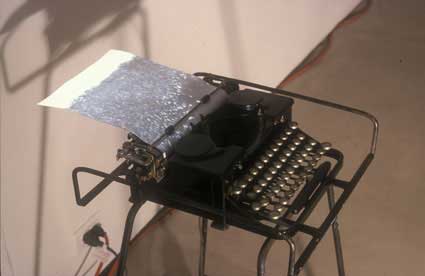
“Letter Never Sent” is a good example of this. In this piece, video footage captured under a dissection microscope is projected onto the space of the typewriter page. Sounds of a woman weeping, a doorbell ringing, and someone knocking on the door are juxtaposed with black ink creeping up the page and fading, and turbulent, dirty water which seems to spit out from the base of the typewriter. With this piece, I was trying to describe one woman’s difficult experience of writing a letter that is erased or never sent because it is too harsh, too truthful. Rather than use words, I used fluids, like emotions, to wash over the page like a wave. The page is filled and emptied again and again, similar to how one might write and edit oneself in pursuit of the perfect correspondence. Even though the work explores one person’s intimate experience, I think we can all relate to written communication, self-censorship and the strong emotions that result.
Yet another video:
You are also teaching at the University of Michigan School of Art and Design. What are your courses about? Can you give us a few examples of your students’ projects?
At this University, I am mostly teaching animation, video and various conceptual classes (this fall, an introductory class on TIME!). The most enjoyable courses focus on creating material for “experimental television broadcasts,” and rethinking the space of the television as an art gallery for time-based work. I know it seems like an old idea since video art first emerged as an alternative to mainstream television, but here at the University of Michigan, we have a unique collaboration with our local PBS station, WFUM. PLAY is a “collaborative project from the University of Michigan School of Art & Design and Michigan Public Media, transforming the gallery space for time-based media.” This project features time-based work (video, animation, documentary, performance, other experimental forms) by faculty and students in the School of Art and Design. Selected pieces air on television as interstitials-in between programs at the top of the hour, say between “The NewsHour with Jim Lehrer” and “Antique Roadshow,” while all submissions are viewable on the web. In my class, “Animation for Broadcast,” students get real-world experience producing fun promotional pieces as well as content (under 3 min.) for this gallery space we call a television. You can see some of their promo animations here. They were encouraged to think about the concept behind PLAY Gallery (an online, virtual place for art, television as gallery space) and play (the activity). They were given the PLAY logo and could do just about anything with it.
I think it’s a really great moment in history to reconsider what television and broadcast can be, do, say: with the YouTube-ization of the world, everyone’s a performer, everyone’s a filmmaker. How does that impact what we make and produce?
Any upcoming project you could tell us about?
I’m working on some totally new and different works. “Timed Release” is a series of performative portraits focusing on people who have developed a creative mental space to survive physical confinement. Paper cutouts and small kinetic sculptures contained in bell jars or other containers are brought to life through video projection to create illusionary shadow theater. It’s an engaging hybrid of image and object…
Thanks Heidi!
The Influencers is a Barcelona-based event which explores controversial forms of art and communication guerrilla, presenting independent projects that play with global popular culture, infiltrate the mass media, and transform fashions, consumption and technological fetishism.
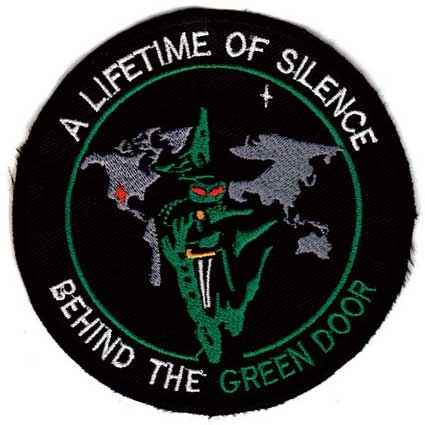
One of Paglen’s patches
It was one of the very few conferences i shouldn’t have missed this year. Well… i did. But life has its little consolations and the videos of The Influencers have just found their way online. Most of them at least, the missing ones will be there in the next few days. In the meantime, hurray! There is Trevor Paglen (video) and Brody Condon (video). There’s also wondrous Santiago Cirugeda (video), he speaks in spanish and one day, maybe one day, i will translate his talk and publish the text here.
Back in July, while i was visiting Documenta 12 in Kassel, i saw a 16-metre-long flower-bed raised above the ground, with 70 packets of seeds sprouting from the grass, each of them carrying worrying labels that documented the latest form of Colonialism: biopiracy.
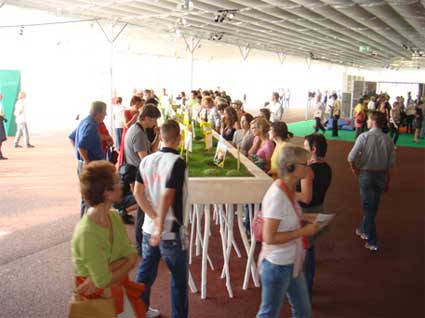
Photo documenta 12
Biopiracy describes a new form of “colonial pillaging” in which western corporations reap profits by taking out patents on indigenous plants, food, local knowledge, human tissues and drugs from developing countries and turning them into lucrative products. Only in few cases are the benefits shared with the country of origin.
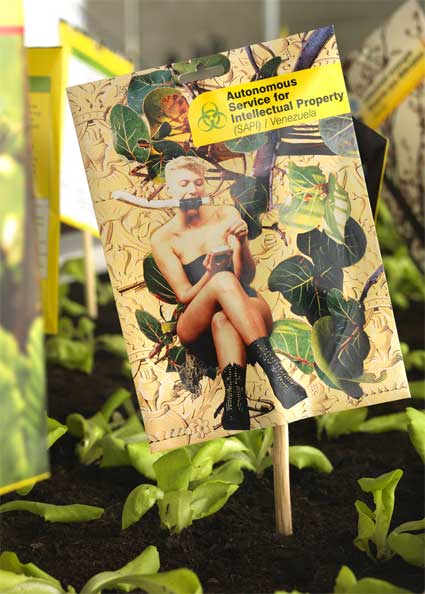
Biopiracy targets particularly countries known for their exceptionally high level of cultural and biological variety: Mexico, India, Brazil, Indonesia and Australia. This process is also referred to as “internal conquest” in analogy to the “external conquest” of colonialism.
In her Siegesgärten (Victory gardens, 2007) installation, Vienna artist Ines Doujak criticized the bio-politics of EU and the USA which turn a blind eye on the ruthless economization of nature and of life. The seed packets sprouting from the flower-bed informed visitors about global exploitation, genetic engineering and monoculture. On the front of the packets are photo-collages showing drag queens and kings and fetish secual practices set in exotic natural settings. On the back, the conditions and consequences of biopiracy are described and illustrated using real examples of the practice.
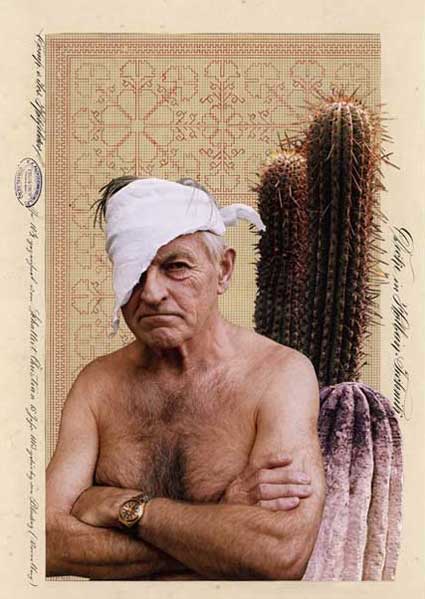
“We fear an increasing dependency on large corporations that seek to control global food production and agriculture by means of patents, from milk to bread and from baking grains to energy plants”, explained patent expert Christoph Then (via no patents on seeds.)
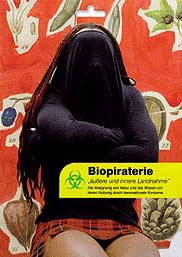
I had kept the artwork somewhere in the back of my mind, feeling that i needed to investigate the matter deeper. Now, Doujak has collected the images and texts relating to her work in a book which is partly in german and partly in english.
This is an eye-opening book (at least for me). I don’t think i’ll ever shop the same way again. Except that it’s not going to be easy. I can boycott a few cosmetics but how could i live without the giant which has been accused of being the “biggest threat to genetic privacy” for its alleged plan to create a searchable database of genetic information: Google? In her book, Doujak retraces many cases of biopiracy, while giving a context for the practice.
In 1980, Ananda Chakrabarty became the first person to receive a patent for a transgenic organism, a bacterium he had engineered to digest oil. Previously, life forms had been excluded from patent laws. The landmark patent has since paved the way for many others on genetically modified micro-organisms and other life forms.
5 years later, the U.S. Patent and Trademark Office allowed GM plants, seeds and plant tissues to be patented. And by 1987 animal patenting followed. Today even human gene sequences, cell lines and stem cells are permitted. Corporate interests can thus corner life forms for the lifetime of a patent and have a monopoly on their exploitation. With the advent of nanotechnology comes the rise of what the Captain Hook Awards call the nanopirates, those who claim ownership of the molecules and even the elements that everything is made from.
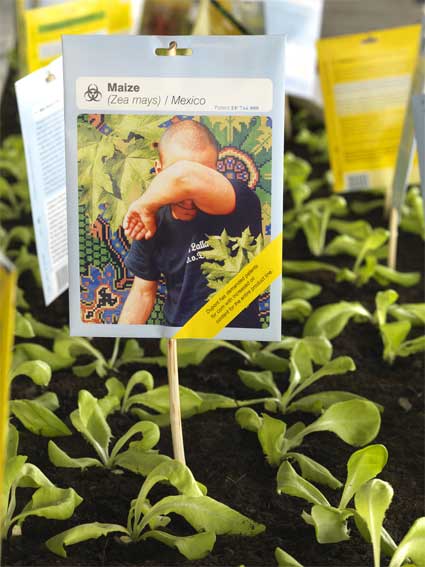
Image documenta 12
As Ines Doujak writes in the book:
The stories collected by the artists are fearsome, here’s just a couple of them:
– Genetic material from members of some indigenous communities in Brazil and Venezuela can be purchased for 85 dollars through the Internet. It is unclear whether the samples were obtained with the full and informed consent of the individuals and of the Brazilian government. Another issue is whether there are guarantees in place to ensure equitable distribution of the knowledge and profits generated from the samples.
– A coalition of indigenous farmers in Peru protests against the multinational corporation Syngenta’s patent for ‘terminator technology’ potatoes. The patent involves a genetic-modification process that ‘switch off’ seed fertility, and can therefore prevent farmers from using, storing and sharing seeds and storage organs such as potato tubers. The Indigenous Coalition Against Biopiracy in the Andes says that by commercialising such potatoes, the corporation would threaten more than 3,000 local potato varieties that form the basis of livelihoods and culture for millions of poor people. They also fear that pollen from the modified potatoes could contaminate local varieties and prevent their tubers from sprouting.
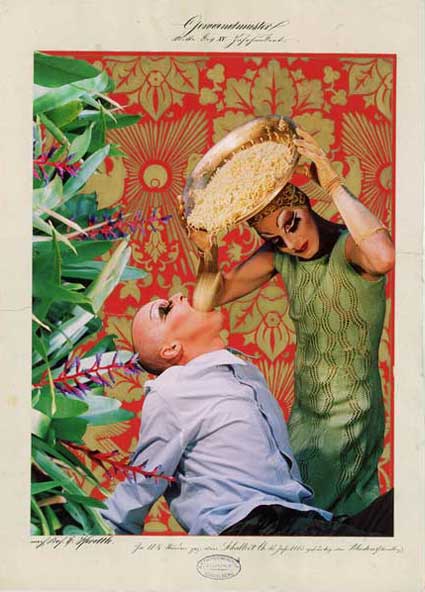
Some of the cases described in the book are comforting, they show how organized action can reverse unfair processes. That’s what happened with quinoa, a plant cultivated in the Andes for 6000 years. In 1994, scientists from Colorado University were granted a patent to a Bolivian species. This means they could also control the rights to any hybrids created using the Apelawa variety, including many traditional varieties grown by peasant farmers in Bolivia, Peru, Ecuador and Chile as well as varieties important in Bolivia’s quinoa export market.
As the president of the Bolivian National Association of Quinoa Producers said at the time: “Our intellectual integrity has been violated by this patent,” he said, “Quinoa has been developed by the Andean agriculturists for millennia, it wasn’t ‘invented’ by researchers in North America.” Protests proved successful: the patent was dropped in 1998.
A second case with annulment of a questionable patent concerns the Hagahai people (Papua New Guinea). Their first contact with the outside world was in 1984. Viruses and illnesses resulted in this contact decimated the Hagahai to such extent that they were under threat of extinction. Foreign researchers administered the vaccination needed but also took some DNA samples (without their knowledge). They discovered that the people is immune to leukaemia and degenerative neurological illnesses. The genetic qualities of the Hagahai were patented in the United States. Worldwide protests led to the annulment of the patent.
More images
from her work at documenta, Kassel.